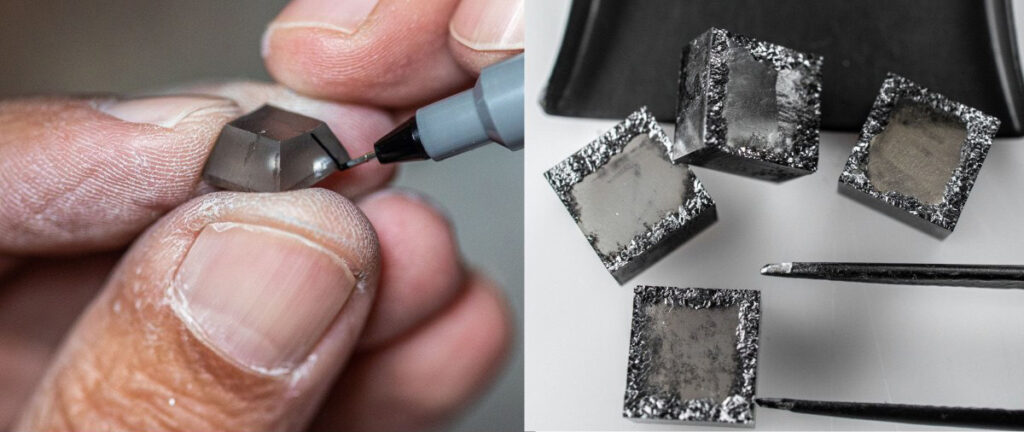Since 1985
Lab & Natural Diamonds
At Hendrickson’s Fine Jewelry, we pride ourselves on in-house repair services. We have four Jewelers working in the store with over 130 Years of experience combined!

Earth grown natural rough diamonds

Laboratory grown rough diamonds
Where do natural (Earth-grown) diamonds come from and how are they formed?
Natural diamonds are magical. They are made from heat and pressure deep within the earth and take millions of years to form. These diamonds are formed from carbon that was trapped in the mantle during the earth’s creation. We have the pleasure of seeing them, touching them and owning them after they are shot up closer to the surface by vertical volcanic eruptions. Most of the time diamonds are mined with machinery, fuel and a lot of labor to dig these diamonds from the earth. There are not many things in this world that are older than a natural diamond.
Where do laboratory grown diamonds come from and how are they formed?
1) Chemical Vapor Deposition (CVD). When this method is used, there is a thin seed of a diamond that is placed in a vacuum chamber. It is then subjected to high-temperature conditions along with carbon-rich gas that is released into the chamber. The carbon gas breaks molecular bonds that allow the carbon to attach to the diamond seed. As it grows, it results in the formation of a diamond. It takes anywhere between a few weeks to months to create a CVD diamond.
2) High-Pressure High Temperature (HPHT). This growth process subjects carbon to extreme temperatures and pressures and is meant to replicate the earth’s natural growing process. When this method is used, there is a small diamond seed that is placed into pure carbon. The diamond seed is exposed to intense pressure and heat, the carbon melts and begins to form around the seed. Then, the substance is carefully cooled to form a diamond. It takes anywhere between a few days to a few weeks to create an HPHT diamond.
What makes a diamond special?
With a diamond…the light goes in the top of the stone, bounces around the faceting, and comes back out the top of the stone. There is no other stone that sparkles the way a diamond does. All other stones, light goes in the top and out the back of the stone. This is why, even when a diamond is dirty, it still sparkles and all other stones when dirty look cloudy.
What is the difference between Laboratory-grown diamonds and natural diamonds?
With a diamond…the light goes in the top of the stone, bounces around the faceting, and comes back out the top of the stone. There is no other stone that sparkles the way a diamond does. All other stones, light goes in the top and out the back of the stone. This is why, even when a diamond is dirty, it still sparkles and all other stones when dirty look cloudy.
What is the price difference between laboratory-grown diamonds and natural diamonds?
Natural (earth-grown diamonds) are more expensive because they are rare, harder to find, and difficult to mine.
Laboratory-grown diamonds are less expensive because there are more of them available.
Why would you buy a Natural (earth-grown diamond)?
The feeling of knowing it is rare.
*We only purchase natural diamonds from reputable dealers that have established conflict-free diamonds and abide by the patriot act.
Why would you buy a Laboratory grown diamond?
Laboratory-grown diamonds are priced lower because of the abundance. This means you can purchase a larger, better-quality diamond and get the same sparkle.
Whatever your choice is, we are here to help you make the perfect one. We will educate you and show you the differences in person. This way you can feel comfortable in the choice you make.
Excellence and Care in Every Detail
Our service is defined by exceptional craftsmanship and a commitment to quality. We take pride in offering personalized attention to meet your unique needs. From custom designs to expert repairs, we ensure every piece receives the utmost care and precision.
Need an Appointment
Have questions about choosing the right diamond?
Let our experts guide you through the differences between lab-grown and natural diamonds, helping you make the perfect choice for your design and budget.
